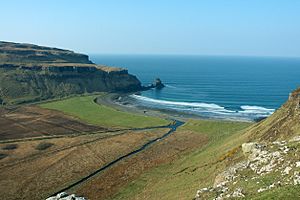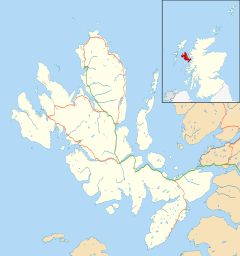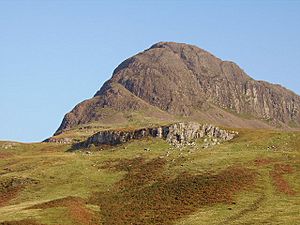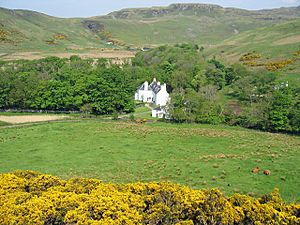Talisker facts for kids
Quick facts for kids Talisker
|
|
|---|---|
 Talisker Bay |
|
| OS grid reference | NG3230 |
| Council area | |
| Lieutenancy area | |
| Country | Scotland |
| Sovereign state | United Kingdom |
| Post town | ISLE OF SKYE |
| Postcode district | IV47 |
| Dialling code | 01478 |
| Police | Northern |
| Fire | Highlands and Islands |
| Ambulance | Scottish |
| EU Parliament | Scotland |
| UK Parliament |
|
| Scottish Parliament | |
Talisker (Scottish Gaelic: Talasgair) is a small community found on the Minginish peninsula. This beautiful area is located on the Isle of Skye in Scotland.
Contents
History of Talisker
For many centuries, Talisker belonged to the Clan Macleod. This was a powerful family in Scotland. A special branch of the family, started by Sir Roderick Macleod, owned Talisker for almost 200 years. Sir Roderick was knighted in 1661 for helping the king.
A blind harp player named Ruaidhri Dall MacMhurich wrote a sad song about John Macleod, who was the second owner of Talisker.
Famous Visitors to Talisker
In 1773, two famous writers, Samuel Johnson and James Boswell, visited Talisker. Johnson was impressed by their host, John Macleod, who managed the land. However, Johnson found the place itself very quiet. He wrote that it was a place where someone could "grow old in meditation." This means it was a perfect spot for quiet thinking.
Boswell agreed that Talisker was a very quiet place. But he thought it was "better than one commonly finds in Sky." This suggests it was a nicer place than many others on the island.
In 1820, Donald Macleod, who was a soldier, sold his part of Talisker. He then moved to Van Diemen’s Land, which is now called Tasmania, in Australia. He traveled with 36 people from his area.
Changes to the Land
In 1825, Hugh MacAskill took over the Talisker estate. He continued a process called the Highland Clearances. This was when many people were moved off their land. Five years later, he started the Talisker distillery. This famous distillery is actually about 5 miles (8 km) away from Talisker, in a place called Carbost, Loch Harport.
Geology and Nature of Talisker
The Talisker area has two hills that are very interesting to scientists. These are Preshal More and Preshal Beg. Scientists have studied the rocks here. They found special layers of rock that show how volcanoes shaped the land a long time ago. These rocks tell a story about ancient lava flows.
Special Protected Area
NatureScot, a group that protects nature in Scotland, has made Talisker a Site of Special Scientific Interest. This means it's a very important place for nature. This is partly because of its unique rocks. It's also because two rare kinds of moths live there. These are the Talisker burnet moth and the transparent burnet moth.
Talisker in Literature
The famous Scottish poet Sorley Maclean wrote a poem called Tràighean. It starts by describing the beautiful natural features of Talisker. He talks about the "great white mouth" of the bay. He also mentions the "hard jaws" of the cliffs. The poem shows how much he loved the landscape.
Here is a part of his poem, translated into English:
If we were in Talisker on the shore
where the great white mouth
opens between two hard jaws,
Rubha nan Clach and the Bioda Ruadh,
I would stand beside the sea
renewing love in my spirit
while the ocean was filling
Talisker bay forever:
I would stand there on the bareness of the shore
until Prishal bowed his stallion head.
Talisker Today
Talisker Farm now covers a large area of about 2,475 acres (1,000 hectares). The main house, called Talisker House, is a beautiful old building. It was started in 1717 and made bigger over the years. It has been a Listed building since 1971. This means it's a special building that is protected.
The house has two floors and an attic. It has many windows and a slate roof. Inside, some rooms have fancy plaster ceilings. The dining room ceiling was added in 1865.
Visiting Talisker Bay
The shore at Talisker Bay is a popular place for walkers. You can reach it by following a footpath. It's a lovely beach with both dark and light sand. The sand often mixes together to create cool patterns.
On one side of the bay, there are tall cliffs and a waterfall. On the other side, there is a big rock formation in the sea. It's best to visit the bay when the tide is low.




